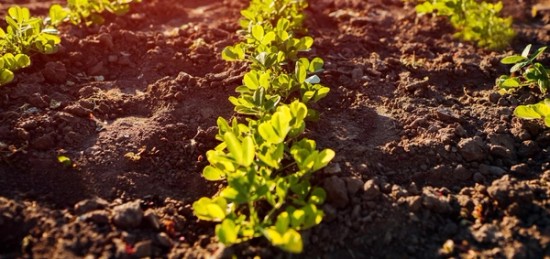As restaurants and consumer packaged goods (CPG) companies factor sustainability into their entire operation, single-use plastic straws are increasingly getting eighty-sixed. With so many other sources of waste littering waterways, eliminating the use of plastic straws is unlikely to save the world’s oceans. But thinking small and making incremental changes may encourage the development of innovations that over time can have a much bigger impact in achieving sustainable goals.
Peanut breeders are thinking small and innovating with peanut seeds to improve the sustainability of peanut production. Developing new varieties that maximize peanuts’ already sustainable traits can help reduce the environmental impact of peanut farming, make production more cost-effective for farmers and make peanuts one of the most sustainable crops.
Sustainable by Nature
“When you really look at it, peanuts are a very hardy crop,” said Kelly Chamberlin, research biologist and peanut breeder with the USDA’s Agricultural Research Service in Stillwater, Oklahoma. Peanuts benefit from their small stature that requires significantly less water than tree nuts. In fact, peanuts are the most water-efficient nut, using only 3.2 gallons of water to produce one ounce of peanuts. They’re also nitrogen-fixing which reduces their need for fertilizers and even benefits the soil and other rotation crops.
Chamberlin breeds peanut varieties using traditional techniques without genetic modification that can withstand environmental stressors affecting peanut farmers in the Southwest. Her research has led to a variety of runner peanut that is highly resistant to a chronic plant disease that affects peanuts in the region.
“The disease instance is below 10% and most of the time below 5% in fields where a susceptible variety would normally get 60% to 80%," Chamberlain said of the new variety. "So, it’s got really good resistance.”
Healthy & Abundant Crop with Fewer Chemicals
A healthy plant may not mean much for consumers, but for farmers it means that they don’t have to treat for pests that spread the disease. Chamberlin says that not only reduces the amount of pesticide in the environment, but also saves farmers $100-$150 per acre.
Some people believe that farmers spray tons of chemicals to maintain their crops. The reality is that farmers don’t want to apply anything to their crops unless they must. One of the reasons to reduce inputs is that they are expensive and making a profit is hard enough without adding extra costs. Sustainability means reducing impacts on the environment and also making farming sustainable for future generations.
“It’s really important to keep peanuts on the forefront of economic potential for farmers,” said Barry Tillman, Ph.D., professor at the University of Florida’s Institute of Food and Agricultural Sciences.
Tillman argues that peanuts become even more sustainable when a farmer can produce more while maintaining similar inputs to the crop. His research focuses not just on the plant’s health and disease resistance, but also on improving yields.
“I guess the way I see it is that per pound of peanuts produced, we’re definitely becoming more sustainable because we’re producing more pounds out of that same acre without increasing the inputs,” Tillman said. “So, over time that gives you more sustainable production.”
Per acre peanut yields have increased 30-40% on average over the past few years and nearly doubled in some areas. Farmers have also been able to decrease inputs like water and crop protectants. It’s all thanks to even hardier varieties that researchers are breeding.
“When older varieties were grown…the average production yield was about 2,900 pounds per acre,” said Maria Balota, Ph.D., associate professor at Virginia Tech in reference to varieties grown in the Virginia-Carolinas region. “From 2011 to 2017, the state’s average yield was 4,200 [pounds per acre]. So, it is a huge, tremendous increase.”
Balota works on a breeding program in coordination with researchers in both North and South Carolina. These researchers have found success in improving both disease resistance and yield by breeding in traits from a wild peanut species.
Genome Map Makes Key Traits Easier to Find
Plant breeding is a tedious process that takes a long time to produce results. Over the past several years, innovations like genome mapping have helped researchers discover the origins of the peanut plant and its genetic code. Now that the peanut genome has been mapped, researchers across the peanut belt hope to identify genetic markers with ideal characteristics that will speed up the breeding process.
Beneficial traits such as disease resistance and drought tolerance are being looked at in both wild and conventional varieties. Some researchers even hope to identify traits that shorten the number of growing days to reduce water use and exposure to environmental extremes that can hurt a crop.
“When there’s a drought, the farmers really have to up their input costs by putting water to the fence, so that’s a big expense,” Chamberlin said. “We try to get our varieties to be as early maturing as possible because we face early freezes out here a lot. Environmental extremes like really hot, dry summers and then early freezes are the two environmental stressors that are driving how a farmer produces his crop.”
For peanuts, the seeds of sustainability are built in. Innovations in breeding and small changes that improve new varieties will maximize their potential and better position both peanuts and farmers for a more sustainable future, while also meeting the needs of sustainably minded consumers and businesses.
